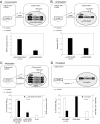Synthetic ecosystems based on airborne inter- and intrakingdom communication
- PMID: 17551014
- PMCID: PMC1886003
- DOI: 10.1073/pnas.0701382104
Synthetic ecosystems based on airborne inter- and intrakingdom communication
Abstract
Intercellular communication within an organism, between populations, or across species and kingdoms forms the basis of many ecosystems in which organisms coexist through symbiotic, parasitic, or predator-prey relationships. Using multistep airborne communication and signal transduction, we present synthetic ecosystems within a mammalian cell population, in mice, or across species and kingdoms. Inter- and intrakingdom communication was enabled by using sender cells that produce volatile aldehydes, small vitamin-derived molecules, or antibiotics that diffuse, by gas or liquid phase, to receiver cells and induce the expression of specific target genes. Intercellular and cross-kingdom communication was shown to enable quorum sensing between and among mammalian cells, bacteria, yeast, and plants, resulting in precise spatiotemporal control of IFN-beta production. Interconnection of bacterial, yeast, and mammalian cell signaling enabled the construction of multistep signal transduction and processing networks as well as the design of synthetic ecosystems that mimic fundamental coexistence patterns in nature, including symbiosis, parasitism, and oscillating predator-prey interactions.
Conflict of interest statement
The authors declare no conflict of interest.
Figures




References
Publication types
MeSH terms
Substances
LinkOut - more resources
Full Text Sources
Other Literature Sources

